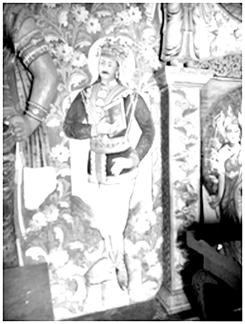|
Book launch
Buddhist history visually narrated
'Buddhist Image Houses' a visual journey through the Buddhist history
of Sri Lanka, from the period of the kings of Kandy to the early years
of Independence, authored by Asoka de Zoysa and Vajira Nalinda
Jayatilaka, was launched at the Auditorium of the Goethe Institut on
Thursday January 28, with Manel Fonseka, wife of the late Prof. Senake
Bandaranayake, as the Chief Guest. The book is dedicated to the memory
of Professor Bandaranayake, deemed Sri Lanka's greatest art historian
and archaeologist of recent times.
Themetically arranged, the book covers a range of Buddhist temples of
Sri Lanka, with images of murals, statues, architecture, interior design
and calligraphy placed in the context of social and political changes
taking place in a small island that was totally dominated by colonial
powers in the 19th century and gained independence in 1948.
|

Book: Buddhist Image Houses
Authors: Asoka de Zoysa
and Vajira Nalinda Jayatilaka |
A visual introduction to the picture programs in the Theravada
tradition, the book is for both the devotee and the modern visitor to
Sri Lanka, thereby guiding the reader into the world of Buddhist ritual
practice, cosmology, mythology and history of about 200 years. A key
theme of the book is how Sri Lankan culture occilates between the
Western and Indian concepts.
The hacket illustration shows an enigmatic figure at the entrance to
the Image House at the Ovitigala SriSunandaramaya close to Horana, with
the following excerpt:
'The figure could not possibly be a protective figure like the
Cobra-hooded Nagarajasguarding the entrance. Judging by the screwed up
moustache, tight fitting breeches and coat also the black pointed shoes,
he is dressed as a rich entrepreneur very much integrated in the
colonial administration. The embroidery on the coat and the fancy crown
may demonstrate that he is made to look like some exotic prince. The
white halo elevates his position among other figures in the vestibule.
The brown leather bound book he holds poses the biggest problem. It
seems to be a kind of diary, because the Roman script indicates that it
is a Denapota, a diary. The correct pronunciation in Sinhala that would
be Dinapotha is written using the Devanagari script. The spine too
written in Devanagaritoo. It can be read as 'me potha' translated from
Sinhala to English as 'this book' bearing the date 1827.'
The Inside cover has the Vessantara Jatakaya from the Ranvella
Navamunisä Viharaya, Giniwella close to Galle.
Some of the aspects highlighted in this volume of Buddhist Image
House are analysed and interpreted in academic essays in Evolving
Traditions of Buddhist Image Houses.The more curious reader is then
invited to the website Samkathana.lk to browse the images grouped under
the name of each temple featureed in both volumes. The website also
provides addresses, contact details, maps and detailed instructions to
actually visit each RajamahaViharaya and PuranaViharaya.
The book is venture by the Samkathana Research Team of the Higher
Education for the Twenty First Century (HETC) Project at the Faculty of
Humanities, University of Kelaniya. The Team is also expected to
facilitate further research though the large archive that was made
possible with part of the funding granted by the project HETC to the
Faculty of Humanities.
Asoka de Zoysa, MA PhD, from FreieUniversität Berlin, had his
training at the Institutfürindische Philologieund Kunstgeschichte,
Berlin, to read Sanskrit, Pali and hybrid-Hindi texts and interpret the
art of India and the Himalayan region.
His doctoral thesis 'Blutru¨nstige Braminen am heiligen Strome'
(1997) published in Frankfurt, analyses how India was represented in the
18th and 19th century popular genres of opera and theater of Germany,
France and England. His current research interests are centered on the
Buddhist Temple. He is visiting lecturer at the University of Visual and
Performing Arts and consultant at the Academy of Design Colombo.
Vajira Nalinda Jayathilaka is an artist, graphic designer and art
historian, who graduated from the University of Kelaniya. A member of
the inaugural teaching faculty of the Visual and Performing Arts Unit at
Kelaniya, he has since 2010 been a lecturer of the Department of History
& Art Theory, Faculty of Visual Arts, in the University of Visual and
Performing Arts, Sri Lanka delivering course units in Sri Lankan folk
art and modern and contemporary art.
He has been engaged in copying and photographing Buddhist murals and
decorative designs for the past several years, which his research
interests contextualising the heritage of Sri Lankan art in Cultural
Studies and Post-Modern Theories. |

